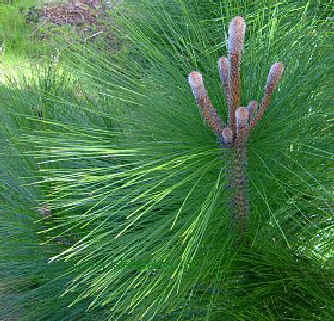 |
PO
Box 9021, Wilmington, DE 19809, USA
E-mail: font@focusonnature.com
Phone: Toll-free in USA 1-888-721-3555
or 302/529-1876 |
 Interesting
Plants
Interesting
Plants
of the
Canary
Islands
noting those during
Focus On Nature Tours
with an (*)
1996 thru 2014
during the months of June
& July
The following list of
Canary Islands Plants compiled by Armas Hill
Photo at upper right: the endemic CANARY PINE
There have been 6 FONT
tours in the Canary Islands.
Links:
Upcoming FONT Birding & Nature Tours in Spain & the Canary Islands
Birds
of the Canary Islands
Mammals
& Marine Life of the Canary Islands
Butterflies,
Dragonflies, & Damselflies in the Canary Islands
Amphibians
& Reptiles of the Canary Islands
Directory of Photos in this Website

The Canary Islands are famous for their high endemism. Almost half of the
1,270 indigenous plants of the Canaries are endemic and often only occur on
single islands.
Additionally, about 680 alien plants have been introduced in the Canary Islands.
A Listing of Canary
Island Plants:
In
the SUBTROPICAL SUCCULENT BUSH:
On the south sides of the western islands, as well as the higher mountains on
Fuerteventura and Lanzarote
- Euphorbiaceae
______ (dominates)
- Candelarum Milkweed
______
Euphorbia canariensis
- Ceropegia
______
- Allagopappus
______
- Aeonium species
______
- Kleinia neriifolia
______
- Dragon's Tree ______
(only a few wild specimens still exist)
Dracaena drago
- Canary Palm
______ (some larger numbers have remained in wet places, e.g. Valle
Gran Rey on La Gomera)
Phoenix canariensis
- Opuntia
______ (introduced from South America)
- Agava
______ (introduced from South America)
At Upper Limits of Xeric Basal Regions:
- Juniperus
phoenicea ______
- Juniperus cedrus
______ EH GC TE (at higher altitudes
than Juniperus phoenices)
Nearly
vegetation-free SEMI-DESERT:
(in the same geographic areas as the previous grouping)
- Launaea
arborescens (= Zollikoferia spinosa) ______
- Zygophyllum
fontanesii ______
- Suaeda
species ______
- Salsola
species ______
Desert flowers:
- Matthiola
parviflora ______
- Echium
lancerottense ______
- Mesembryanthemum
species ______
- Chrysanthemum
coronarium ______
- Reichardia tingitana ______
- Asphodelus
tenuifolius ______ (a perennial)
- Lotus
lancerottensis ______ (a perennial)
- Kickxia sagittata
______ (a perennial)
- Tamaris species ______
(specialist halophytic, salt-tolerant plants
along the coast, where not destroyed by the development of tourist
facilities)
The
LAUREL FOREST:
Characteristic trees of the Laurel Forest:
- Laurus azorica
(= Laurus canariensis) ______ (the most common
representative)
- Persea indica
______
- Apollonias
barbujana ______
- Ocotea foetens
______
- Viburnum tinus
______ (dominates the shrub layer)
- Pteridium
aquilinum ______ (a fern, in wet places)
- Smilax
______ (a climber)
- Convolvulus
canariensis ______ (a climber)
- Hedera canariensis
______ (a climber)
-
Erica arborea ______ (a tree heather,
in degraded areas)
- Myrica faya
______ (can grow up to 20 meters high, in degraded areas)
- Ilex canariensis
______
(dominates the shrub layer , in degraded areas)
- Phyllis nobla
______ (dominates the shrub layer, in degraded areas)
- Rhamnus glanulosa
______ (an endemic plant along forest tracks)
- Cedronella
canariensis ______ (an endemic plant along forest
tracks)
- Urtica morifolia
______ (an endemic plant along forest tracks)
- Gesnouinia arborea
______ (an endemic plant along forest tracks)
- Canary Dwarf Shrub Heather ______
(Tomillares)
- Genista -like
species in the genera:
Adenocarpus ______
Cytisus ______
Cahrmaecytisus ______
Teline ______
Ulex ______
- Dittrichia
(= Inula) viscosa ______
- Cistus
______
- Lavandula species
______
- Micromeria
species ______
The PINE
FORESTS:
- Canary Pine ______ (PHOTO
AT TOP OF FILE)
Pinus canariensis
- Pinus radiata
______ (introduced from North America)
- Cistus species
______ (in the herb & shrub layer)
- Cytisus
species ______
(in the herb & shrub layer)
The MOUNTAIN
SEMI-DESERT:
Globose and often spiny shrubs
- Saprtocytisus
supramubium ______ (white-flowering) (in the family
FABACEAE)
- Adenocarpus viscosus
______ (yellow-flowering) (in the family FABACEAE)
(flowers in the spring & summer)
- Pterocephalus
lasiospermus ______ (violet-flowering) (flowers in the
spring & summer)
- Crucifer ______ (flowers in the
spring)
Descurainia
bourgaeana
- Erysimum scoparium
______ (flowers in the spring)
- Echium wildpretti
______
Echium wildpretti is especially striking, with candle-like strands more than
2 meters high)
Alpine-like SCREE
COMMUNITIES:
- Viola cheiranthifolia
______
Viola cheiranthifolia is
an Canarian endemic violet, and the only vascular plant of the islands. It
occurs above 2,600 meters in elevation on Mount Teide on Tenerife.
To
Top of Page



 Interesting
Plants
Interesting
Plants![]()
![]()